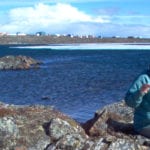The Canadian Geotechnical Journal is proud to have Dr. Craig Lake join the Editorial Board as Co-Editor. Dr. Lake and his students study waste containment systems: from design, performance, and degradation of soil barriers to testing synthetic materials that filter seepage from wastewater ponds. Get to know Dr. Lake in our latest Q&A.
Welcome aboard! You completed your Bachelor of Civil Engineering at the Technical University of Nova Scotia and are back in Halifax as a Geotechnical Engineering Professor at Dalhousie University. Where did life take you in between?
After I finished my undergraduate degree in Nova Scotia, I worked for four months as a geotechnical engineer for a local company in Halifax called EarthTech Engineering. At the beginning of this job I had already decided I was going to attend Western University in London, Ontario, and work under one of the most active geotechnical researchers in Canada, Dr. Kerry Rowe (an Associate Editor with the CGJ since 1983). At the end of August, I packed all my belongings into a small rail container and drove my Toyota Tercel from Halifax to London in two days. I spent the next five years in London researching landfill liner systems and how different contaminants migrate through these liners.
I actually secured a job before I graduated with my PhD. I was recruited by a company named Jacques Whitford whose head office was in Halifax. I had two co-op work terms there as an undergraduate student and they were looking to add to their geotechnical group. During the two years working at Jacques Whitford post-PhD, I performed geotechnical site investigations and designs for various buildings, roads, bridges, subdivisions, marine facilities, and waste disposal facilities. One job involved spending 30 days on a ship taking soil samples from the ocean floor for several oil platforms and production facilities 300 km offshore of Newfoundland. I really enjoyed the variety and high pace of consulting engineering. I also learned a lot from very experienced geotechnical engineers—knowledge that has stayed with me to this day. When a faculty position opened up at Dalhousie University, I decided to apply and secured a position.
How did you find yourself first studying waste and contaminant management?
Honestly, by chance. I had started doing a master’s degree with Dr. Rowe on geomechanics research (using modelling to study the behaviour of soils under different loads). However, after taking a graduate course from him on waste containment and barrier systems, I switched topics, transferred into a PhD, and the rest is history.
If you had only 50 words to explain what you do, what would you say?
My graduate students and I measure the effectiveness of different containment systems with respect to how contaminants move through them. We then try to use these measurements to predict the effectiveness of these containment systems into the future.
Where in the world has your field research taken you?
Stinky landfills and contaminated sites in Ontario and Nova Scotia.
How have the engineering issues associated with containment systems evolved since you entered the field?
When I started my PhD, the predominant type of containment system for landfills were naturally occurring and compacted clay; geosynthetics use in liner systems was just beginning. Present day landfill liner systems now frequently incorporate geosynthetics as a required portion of the overall environmental protection system. The use of applied contaminant transport modelling to predict the effectiveness of liner designs was rare. Dr. Rowe led the charge in this line of discovery research. Currently provinces such as Ontario and Nova Scotia require this modelling to be applied if changes are requested to liner designs from those which are specified by industry standards.
You have published work on measuring the impacts of freeze—thaw cycles on the integrity of cement-based containment systems. Why do these cycles matter?
The effectiveness of these types of containment systems to “retain” contaminants relies on them to maintain the majority of their physical properties; not only shortly after construction, but also long into the future. Understanding the mechanisms that cause physical damage to these materials is important to ensure that proper design measures can be implemented to protect the physical integrity of these materials over time.
You serve on the Board for the not-for-profit recycling program Divert NS. Can you tell us about this experience?
This is something that I have been doing for the past two years. Divert NS just celebrated its 20th anniversary. The board oversees the business side of the waste diversion process for the province of Nova Scotia as well as promotes educational initiatives and research and innovation. Serving on this not-for-profit board has actually been a very rewarding experience. I am allowed to get out of my “little research world” and see the big picture of waste management and how my little research world fits into this bigger picture. In Nova Scotia, we have one of the highest rates of waste diversion in North America. Divert NS promotes programs to encourage residents to recycle, reduce, and reuse their products.
What have been the most challenging and the most rewarding aspects of your career to date?
Training students probably represents both the most challenging and yet most rewarding aspect of my job. Every student is different and you can’t treat them the same. I honestly enjoy working with students and the enthusiasm they bring.
What one piece of insight would you share with the next generation of civil and resource engineers?
I would say (and do say) that the world is changing before our eyes. The technological advancements in IT and communications are amazing when you think the internet became “a real thing” in the mid-1990s. The rate at which the world is changing has affected how infrastructure projects develop, substantially. However, the great thing about civil engineering is that for the foreseeable future there is going to be an enormous demand to renew and maintain our infrastructure—find your role in this field, become a “master” at one aspect, and you will be employable for a very long time.
What are you looking forward to in your new position as Co-Editor of the CGJ?
I am quite honoured to be invited as a Co-Editor of the CGJ. The CGJ is considered one of the top geoengineering journals in the world. I am really looking forward to working with my other Co-Editors, Ian Moore and Diachao Sheng, at continually improving the reputation of the journal internationally.
When you’re not on the Dalhousie campus where would we find you?
In the mornings I enjoy running and fitness training as a way to start the day on a positive note. These mornings are the only time I really have to myself! We have two active kids (13 and 15) that keep me running to various rinks for hockey and ringette in the winter and golf courses and soccer fields in the summer. In July and August my family enjoys getting to the ocean and enjoying our great beaches.




